Geospatial Explainable AI Uncovers Eco-Environmental Effects and Its Driving Mechanisms—Evidence from the Poyang Lake Region, China
Abstract
1. Introduction
2. Materials and Methods
2.1. Study Area
2.2. Data Sources and Processing
2.3. Methodology
2.3.1. Land-Use Transfer Matrix Model
2.3.2. Eco-Environmental Quality Index
2.3.3. Ecological Contribution Rate of Land-Use Transitions
2.3.4. Geographic Explainable Artificial Intelligence
2.4. Research Framework
3. Results
3.1. Eco-Environmental Effects of Land-Use Function Evolution
3.1.1. Spatiotemporal Dynamics of PLES Land-Use
3.1.2. Spatiotemporal Patterns of the EQI
3.1.3. Impacts of Land-Use Transitions on Eco-Environmental Quality
3.2. Nonlinear Analysis of the Influencing Factors on EQI
3.2.1. Factor Selection and Model Performance Evaluation
3.2.2. Global Importance and Nonlinear Effects of Factors Influencing EQI
3.3. Spatial Heterogeneity Analysis of Influencing Factors on EQI
3.3.1. Spatial Distribution of the Geoshapley Values of the Top Six Factors
3.3.2. Analysis of Dominant Factors in Different Regions
4. Discussion
4.1. Land-Use Transition and Eco-Environmental Effects
4.2. Exploration of Factors Influencing the EQI
4.3. Reflection and Prospect of Research
5. Conclusions
- From 1990 to 2020, both APS and ecological space in the Poyang Lake Region continuously declined, while IPS and living space increased substantially. The distribution of the EQI exhibited significant spatial heterogeneity, characterized by higher values in the central region, lower values in the surrounding areas, and relatively higher values at the outermost periphery, forming a concentric pattern. During the study period, the EQI showed a persistent downward trend. The conversion of APS to WES and FES was identified as the main factor contributing to ecological improvement. This finding confirms the ecological benefits of policies such as returning farmland to forest and restoring wetlands in the Poyang Lake Region. In contrast, the encroachment of agricultural and urban residential land on ecological land was the primary cause of ecological degradation.
- GeoXAI accurately modeled nonlinear spatial relationships and provided geographic variables to detect previously overlooked spatial drivers. Latent geographic factors had a significant impact on eco-environmental quality. Altitude and PopDens were identified as the most influential features, both demonstrating threshold effects. Socio-economic factors consistently exerted negative impacts. The effects of vegetation factors were complex, generally showing an initial decline followed by an increase.
- Population density was the dominant influencing factor for both high-altitude areas and aquatic environments in the Poyang Lake Region. These areas exhibited high-quality but fragile ecological characteristics and were particularly sensitive to human activities. GEO had a pronounced effect on urban areas. Agricultural development and population aggregation demonstrated threshold effects on ecological quality, indicating that rational allocation can contribute to ecological improvement. The ecological regulatory function of vegetation depended on its ecological benefits, with mid-altitude regions being especially affected.
Author Contributions
Funding
Data Availability Statement
Acknowledgments
Conflicts of Interest
References
- Yang, Y.; Cai, Z. Ecological Security Assessment of the Guanzhong Plain Urban Agglomeration Based on an Adapted Ecological Footprint Model. J. Clean. Prod. 2020, 260, 120973. [Google Scholar] [CrossRef]
- Yang, Y. Evolution of Habitat Quality and Association with Land-Use Changes in Mountainous Areas: A Case Study of the Taihang Mountains in Hebei Province, China. Ecol. Indic. 2021, 129, 107967. [Google Scholar] [CrossRef]
- Long, H. Land Use Policy in China: Introduction. Land Use Policy 2014, 40, 1–5. [Google Scholar] [CrossRef]
- Winkler, K.; Fuchs, R.; Rounsevell, M.; Herold, M. Global Land Use Changes Are Four Times Greater than Previously Estimated. Nat. Commun. 2021, 12, 2501. [Google Scholar] [CrossRef] [PubMed]
- Tian, F.; Li, M.; Han, X.; Liu, H.; Mo, B. A Production–Living–Ecological Space Model for Land-Use Optimisation: A Case Study of the Core Tumen River Region in China. Ecol. Model. 2020, 437, 109310. [Google Scholar] [CrossRef]
- Wang, A.; Liao, X.; Tong, Z.; Du, W.; Zhang, J.; Liu, X.; Liu, M. Spatial-Temporal Dynamic Evaluation of the Ecosystem Service Value from the Perspective of “Production-Living-Ecological” Spaces: A Case Study in Dongliao River Basin, China. J. Clean. Prod. 2022, 333, 130218. [Google Scholar] [CrossRef]
- Lambin, E.F.; Meyfroidt, P. Global Land Use Change, Economic Globalization, and the Looming Land Scarcity. Proc. Natl. Acad. Sci. USA 2011, 108, 3465–3472. [Google Scholar] [CrossRef]
- Hanaček, K.; Rodríguez-Labajos, B. Impacts of Land-Use and Management Changes on Cultural Agroecosystem Services and Environmental Conflicts—A Global Review. Glob. Environ. Change 2018, 50, 41–59. [Google Scholar] [CrossRef]
- Lin, G.; Jiang, D.; Fu, J.; Cao, C.; Zhang, D. Spatial Conflict of Production–Living–Ecological Space and Sustainable-Development Scenario Simulation in Yangtze River Delta Agglomerations. Sustainability 2020, 12, 2175. [Google Scholar] [CrossRef]
- Newbold, T.; Hudson, L.N.; Hill, S.L.L.; Contu, S.; Lysenko, I.; Senior, R.A.; Börger, L.; Bennett, D.J.; Choimes, A.; Collen, B.; et al. Global Effects of Land Use on Local Terrestrial Biodiversity. Nature 2015, 520, 45–50. [Google Scholar] [CrossRef]
- Polasky, S.; Nelson, E.; Pennington, D.; Johnson, K.A. The Impact of Land-Use Change on Ecosystem Services, Biodiversity and Returns to Landowners: A Case Study in the State of Minnesota. Environ. Resour. Econ. 2011, 48, 219–242. [Google Scholar] [CrossRef]
- Pang, R.; Hu, N.; Zhou, J.; Sun, D.; Ye, H. Study on Eco-Environmental Effects of Land-Use Transitions and Their Influencing Factors in the Central and Southern Liaoning Urban Agglomeration: A Production–Living–Ecological Perspective. Land 2022, 11, 937. [Google Scholar] [CrossRef]
- Zhang, S.; Liu, S.; Zhong, Q.; Zhu, K.; Fu, H. Assessing Eco-Environmental Effects and Its Impacts Mechanisms in the Mountainous City: Insights from Ecological–Production–Living Spaces Using Machine Learning Models in Chongqing. Land 2024, 13, 1196. [Google Scholar] [CrossRef]
- Zhou, Q.; Zhu, M.; Qiao, Y.; Zhang, X.; Chen, J. Achieving Resilience through Smart Cities? Evidence from China. Habitat Int. 2021, 111, 102348. [Google Scholar] [CrossRef]
- Li, J.; Sun, W.; Li, M.; Meng, L. Coupling Coordination Degree of Production, Living and Ecological Spaces and Its Influencing Factors in the Yellow River Basin. J. Clean. Prod. 2021, 298, 126803. [Google Scholar] [CrossRef]
- Wang, D.; Jiang, D.; Fu, J.; Lin, G.; Zhang, J. Comprehensive Assessment of Production–Living–Ecological Space Based on the Coupling Coordination Degree Model. Sustainability 2020, 12, 2009. [Google Scholar] [CrossRef]
- Mo, Y.; Bao, Y.; Wang, Z.; Wei, W.; Chen, X. Spatial Coupling Relationship between Architectural Landscape Characteristics and Urban Heat Island in Different Urban Functional Zones. Build. Environ. 2024, 257, 111545. [Google Scholar] [CrossRef]
- Zhou, Y.; Cao, W.; Zhou, J. Land-Use Transfer and Its Ecological Effects in Rapidly Urbanizing Areas: A Case Study of Nanjing, China. Sustainability 2024, 16, 10615. [Google Scholar] [CrossRef]
- Zhang, Y.; Lin, W.; Ren, E.; Yu, Y. Evaluation of Spatial Distribution of Carbon Emissions from Land Use and Environmental Parameters: A Case Study in the Yangtze River Delta Demonstration Zone. Ecol. Indic. 2024, 158, 111496. [Google Scholar] [CrossRef]
- Wang, A. Spatiotemporal Variation of Ecological Carrying Capacity in Dongliao River Basin, China. Ecol. Indic. 2022, 135, 108548. [Google Scholar] [CrossRef]
- Zhang, L.; Zhang, H.; Xu, E. Information Entropy and Elasticity Analysis of the Land Use Structure Change Influencing Eco-Environmental Quality in Qinghai-Tibet Plateau from 1990 to 2015. Environ. Sci. Pollut Res. 2022, 29, 18348–18364. [Google Scholar] [CrossRef] [PubMed]
- Wu, X.; Ding, J.; Lu, B.; Wan, Y.; Shi, L.; Wen, Q. Eco-Environmental Effects of Changes in Territorial Spatial Pattern and Their Driving Forces in Qinghai, China (1980–2020). Land 2022, 11, 1772. [Google Scholar] [CrossRef]
- Zhang, H.; Zhou, Q.; Yang, J.; Xiang, H. Change and Driving Factors of Eco-Environmental Quality in Beijing Green Belts: From the Perspective of Nature-Based Solutions. Ecol. Indic. 2024, 166, 112581. [Google Scholar] [CrossRef]
- Li, H.; Fang, C.; Xia, Y.; Liu, Z.; Wang, W. Multi-Scenario Simulation of Production-Living-Ecological Space in the Poyang Lake Area Based on Remote Sensing and RF-Markov-FLUS Model. Remote Sens. 2022, 14, 2830. [Google Scholar] [CrossRef]
- Hu, J.; Zhang, J.; Li, Y. Exploring the Spatial and Temporal Driving Mechanisms of Landscape Patterns on Habitat Quality in a City Undergoing Rapid Urbanization Based on GTWR and MGWR: The Case of Nanjing, China. Ecol. Indic. 2022, 143, 109333. [Google Scholar] [CrossRef]
- Wang, H.; Liu, C.; Zang, F.; Liu, Y.; Chang, Y.; Huang, G.; Fu, G.; Zhao, C.; Liu, X. Remote Sensing-Based Approach for the Assessing of Ecological Environmental Quality Variations Using Google Earth Engine: A Case Study in the Qilian Mountains, Northwest China. Remote Sens. 2023, 15, 960. [Google Scholar] [CrossRef]
- Vachon, J.; Kerckhoffs, J.; Buteau, S.; Smargiassi, A. Do Machine Learning Methods Improve Prediction of Ambient Air Pollutants with High Spatial Contrast? A Systematic Review. Environ. Res. 2024, 262, 119751. [Google Scholar] [CrossRef]
- He, H.; Wang, J.; Ding, J.; Wang, L. Spatial Downscaling of Precipitation Data in Arid Regions Based on the XGBoost-MGWR Model: A Case Study of the Turpan–Hami Region. Land 2024, 13, 448. [Google Scholar] [CrossRef]
- Zhang, J.; Li, Y.; Fukuda, T.; Wang, B. Urban Safety Perception Assessments via Integrating Multimodal Large Language Models with Street View Images. Cities 2025, 165, 106122. [Google Scholar] [CrossRef]
- Cutler, D.R.; Edwards, T.C.; Beard, K.H.; Cutler, A.; Hess, K.T.; Gibson, J.; Lawler, J.J. Random Forests for Classification in Ecology. Ecology 2007, 88, 2783–2792. [Google Scholar] [CrossRef]
- Ke, E.; Zhao, J.; Zhao, Y. Investigating the Influence of Nonlinear Spatial Heterogeneity in Urban Flooding Factors Using Geographic Explainable Artificial Intelligence. J. Hydrol. 2025, 648, 132398. [Google Scholar] [CrossRef]
- Foroutan, E.; Hu, T.; Li, Z. Revealing Key Factors of Heat-Related Illnesses Using Geospatial Explainable AI Model: A Case Study in Texas, USA. Sustain. Cities Soc. 2025, 122, 106243. [Google Scholar] [CrossRef]
- Chen, Q.; Xu, X.; Wu, M.; Wen, J.; Zou, J. Assessing the Water Conservation Function Based on the InVEST Model: Taking Poyang Lake Region as an Example. Land 2022, 11, 2228. [Google Scholar] [CrossRef]
- Wu, H.; Huang, Q.; Fu, C.; Song, F.; Liu, J.; Li, J. Stable Isotope Signatures of River and Lake Water from Poyang Lake, China: Implications for River–Lake Interactions. J. Hydrol. 2021, 592, 125619. [Google Scholar] [CrossRef]
- Zhu, Z.; Huai, W.; Yang, Z.; Li, D.; Wang, Y. Assessing Habitat Suitability and Habitat Fragmentation for Endangered Siberian Cranes in Poyang Lake Region, China. Ecol. Indic. 2021, 125, 107594. [Google Scholar] [CrossRef]
- Zhang, J.; Laghari, A.A.; Guo, Q.; Liang, J.; Kumar, A.; Liu, Z.; Shen, Y.; Wei, Y. Evolution of Land Use and Its Hydrological Effects in the Fenhe River Basin Under the Production–Living–Ecological Space Perspective. Sustainability 2024, 16, 11170. [Google Scholar] [CrossRef]
- Su, X.; Wang, M.; Zeng, Y.; Gong, J. Land Use Transformation Based on Production-Living-Ecological Space and Associated Eco-Environment Effects: Evidence from the Upper Reaches of the Yangtze River, China. Res. Sq. 2023. [Google Scholar] [CrossRef]
- Li, X.; Fang, C.; Huang, J.; Mao, H. The Urban Land Use Transformations and Associated Effects on Eco-Environment in Northwest China Arid Region: A Case Study in Hexi Region, Gansu Province. Quat. Sci. 2003, 23, 280–290. [Google Scholar]
- Wang, S.; Liu, Z.; Chen, Y.; Fang, C. Factors Influencing Ecosystem Services in the Pearl River Delta, China: Spatiotemporal Differentiation and Varying Importance. Resour. Conserv. Recycl. 2021, 168, 105477. [Google Scholar] [CrossRef]
- Li, P.; Wang, J.; Liu, M.; Xue, Z.; Bagherzadeh, A.; Liu, M. Spatio-Temporal Variation Characteristics of NDVI and Its Response to Climate on the Loess Plateau from 1985 to 2015. Catena 2021, 203, 105331. [Google Scholar] [CrossRef]
- Li, K.; Zhang, B.; Xiao, W.; Lu, Y. Land Use Transformation Based on Production–Living–Ecological Space and Associated Eco-Environment Effects: A Case Study in the Yangtze River Delta Urban Agglomeration. Land 2022, 11, 1076. [Google Scholar] [CrossRef]
- Wang, H. Regional Ecological Risk Assessment with Respect to Human Disturbance in the Poyang Lake Region (PYLR) Using Production–Living–Ecology Analysis. J. Indian Soc. Remote Sens. 2021, 49, 449–460. [Google Scholar] [CrossRef]
- Yang, W.; Li, Y.; Liu, Y.; Fan, P.; Yue, W. Environmental Factors for Outdoor Jogging in Beijing: Insights from Using Explainable Spatial Machine Learning and Massive Trajectory Data. Landsc. Urban Plan. 2024, 243, 104969. [Google Scholar] [CrossRef]
- Wei, L.; Liu, Z. Transportation Infrastructure and Eco-Environmental Quality: Evidence from China’s High-Speed Rail. PLoS ONE 2023, 18, e0290840. [Google Scholar] [CrossRef]
- Cao, J.; Li, T. Analysis of Spatiotemporal Changes in Cultural Heritage Protected Cities and Their Influencing Factors: Evidence from China. Ecol. Indic. 2023, 151, 110327. [Google Scholar] [CrossRef]
- Shen, Z.; Gong, J. Spatial–Temporal Changes and Driving Mechanisms of Ecological Environmental Quality in the Qinghai–Tibet Plateau, China. Land 2024, 13, 2203. [Google Scholar] [CrossRef]
- Hou, Y.; Chen, Y.; Ding, J.; Li, Z.; Li, Y.; Sun, F. Ecological Impacts of Land Use Change in the Arid Tarim River Basin of China. Remote Sens. 2022, 14, 1894. [Google Scholar] [CrossRef]
- Liu, L. An Ensemble Framework for Explainable Geospatial Machine Learning Models. Int. J. Appl. Earth Obs. Geoinf. 2024, 132, 104036. [Google Scholar] [CrossRef]
- Li, Z. GeoShapley: A Game Theory Approach to Measuring Spatial Effects in Machine Learning Models. Ann. Am. Assoc. Geogr. 2024, 114, 1365–1385. [Google Scholar] [CrossRef]
- Wang, W.; Yang, P.; Xia, J.; Zhang, S.; Hu, S. Changes in the Water Environment and Its Major Driving Factors in Poyang Lake from 2016 to 2019, China. Environ. Sci. Pollut. Res. 2023, 30, 3182–3196. [Google Scholar] [CrossRef]
- Pan, F.; Shu, N.; Wan, Q.; Huang, Q. Land Use Function Transition and Associated Ecosystem Service Value Effects Based on Production–Living–Ecological Space: A Case Study in the Three Gorges Reservoir Area. Land 2023, 12, 391. [Google Scholar] [CrossRef]
- Ge, Y.; Dou, W.; Wang, X.; Chen, Y.; Zhang, Z. Identifying Urban–Rural Differences in Social Vulnerability to Natural Hazards: A Case Study of China. Nat. Hazards 2021, 108, 2629–2651. [Google Scholar] [CrossRef]
- Zhang, H.; Chen, M.; Liang, C. Urbanization of County in China: Spatial Patterns and Influencing Factors. J. Geogr. Sci. 2022, 32, 1241–1260. [Google Scholar] [CrossRef]
- Xu, C.; Qian, C.; Yang, W.; Li, B.; Kong, L.; Kong, F. Spatiotemporal Pattern of Urban-Rural Integration Development and Its Driving Mechanism Analysis in Hangzhou Bay Urban Agglomeration. Int. J. Environ. Res. Public Health 2022, 19, 8390. [Google Scholar] [CrossRef]
- Li, R.; Huang, X.; Liu, Y. Spatio-Temporal Differentiation and Influencing Factors of China’s Urbanization from 2010 to 2020. Acta Geogr. Sin 2023, 78, 777–791. [Google Scholar]
- Zhao, D.; Liu, K.; Li, J.; Zhai, J. Spatial Reconstruction and Determinants of Industrial Land in China’s Urban Expansion: A Theoretical Framework. Land 2025, 14, 213. [Google Scholar] [CrossRef]
- Jiang, L.; Wu, S.; Liu, Y. Change Analysis on the Spatio-Temporal Patterns of Main Crop Planting in the Middle Yangtze Plain. Remote Sens. 2022, 14, 1141. [Google Scholar] [CrossRef]
- Lu, X.; Chen, Y.; Fan, X.; Liu, X. Effects of Land Use Transition on Regional Ecological Environment—A Case Study of Zhaosu County, Xinjiang. Land 2024, 13, 2149. [Google Scholar] [CrossRef]
- Wang, Z.Y.; Wan, D.; Liao, J.J.; Lu, J.T.; Wu, F.; Wang, L.K. Ecological Environment Effect and Driving Factors of Transformation of Production-Living-Ecological Space in Dongting Lake Eco-Economic Zone. Sci. Technol. Eng 2023, 23, 3876–3888. [Google Scholar]
- Wang, C.; Xie, W.; Li, T.; Wu, G.; Wu, Y.; Wang, Q.; Xu, Z.; Song, H.; Yang, Y.; Pan, X. Analysis of Spatial and Temporal Variation in Water Coverage in the Sub-Lakes of Poyang Lake Based on Multi-Source Remote Sensing. Remote Sens. 2023, 15, 2788. [Google Scholar] [CrossRef]
- Liu, R.; Dong, J.; Jiang, L.; Ge, Y.; Fan, C.; Yang, T.; Zhang, G. Agricultural Flood Resistance Enhanced after Returning Farmlands to Lakes. Proc. Natl. Acad. Sci. USA 2024, 121, e2410967121. [Google Scholar] [CrossRef]
- Ni, C.-Y.; Wang, W.-Q.; Zeng, H.; Huang, H.-P. The Study on Eco-Compensation of the Returning Field in Lakeside Areas to Poyang Lake (II)–Assessment of Compensation Standards for the Double-Returned Areas in Poyang Lake Wetlands. J. Jiangxi Norm. Univ. (Nat. Sci. Ed.) 2010, 34, 541–546. [Google Scholar]
- Liu, H.; Zheng, L.; Wu, J.; Liao, Y. Past and Future Ecosystem Service Trade-Offs in Poyang Lake Basin under Different Land Use Policy Scenarios. Arab. J. Geosci. 2020, 13, 46. [Google Scholar] [CrossRef]
- Xu, Y.; Li, P.; Pan, J.; Zhang, Y.; Dang, X.; Cao, X.; Cui, J.; Yang, Z. Eco-Environmental Effects and Spatial Heterogeneity of “Production-Ecology-Living” Land Use Transformation: A Case Study for Ningxia, China. Sustainability 2022, 14, 9659. [Google Scholar] [CrossRef]
- Wu, B.; Liu, M.; Wan, Y.; Song, Z. Evolution and Coordination of Cultivated Land Multifunctionality in Poyang Lake Ecological Economic Zone. Sustainability 2023, 15, 5307. [Google Scholar] [CrossRef]
- Rao, J.; Ouyang, X.; Pan, P.; Huang, C.; Li, J.; Ye, Q. Ecological Risk Assessment of Forest Landscapes in Lushan National Nature Reserve in Jiangxi Province, China. Forests 2024, 15, 484. [Google Scholar] [CrossRef]
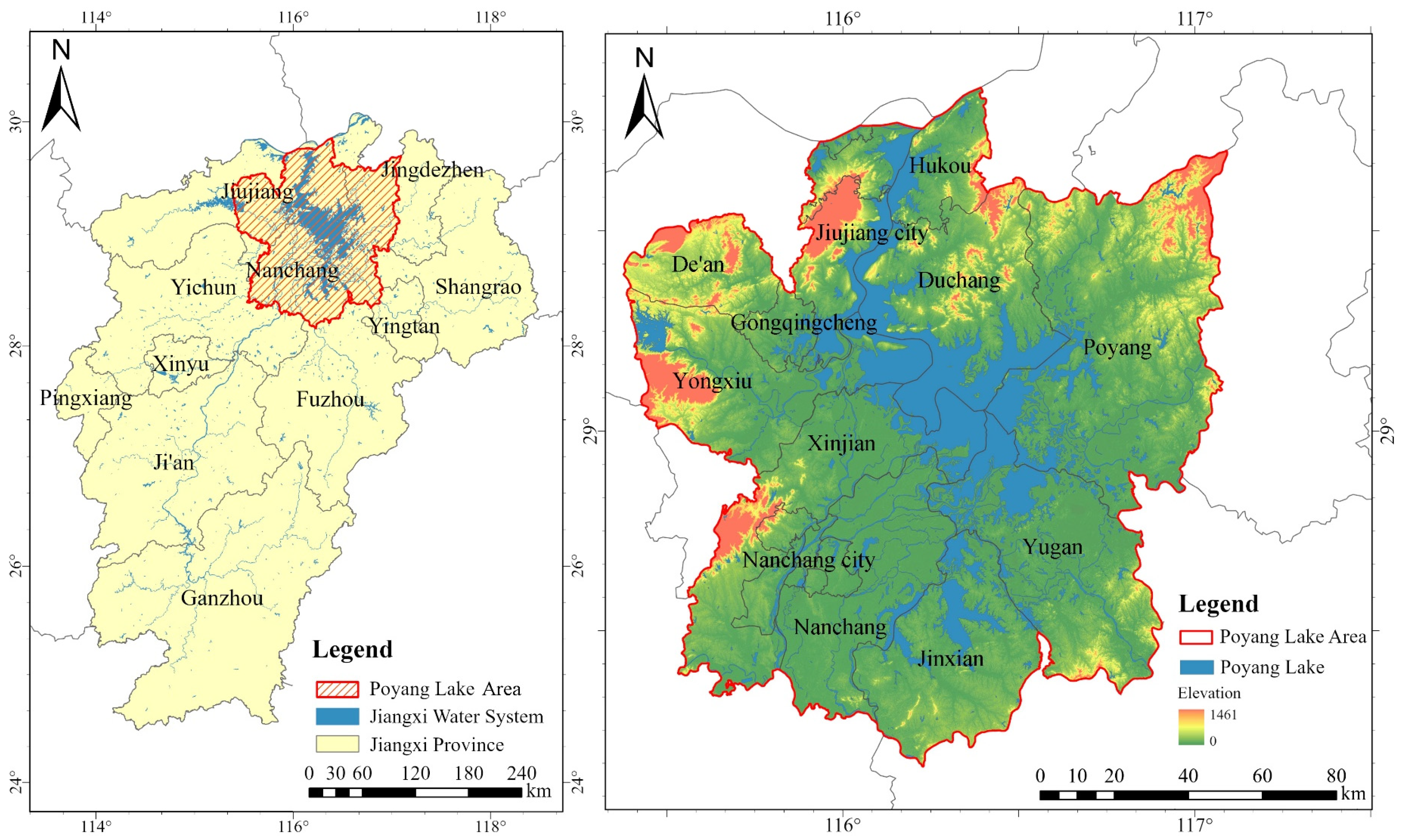
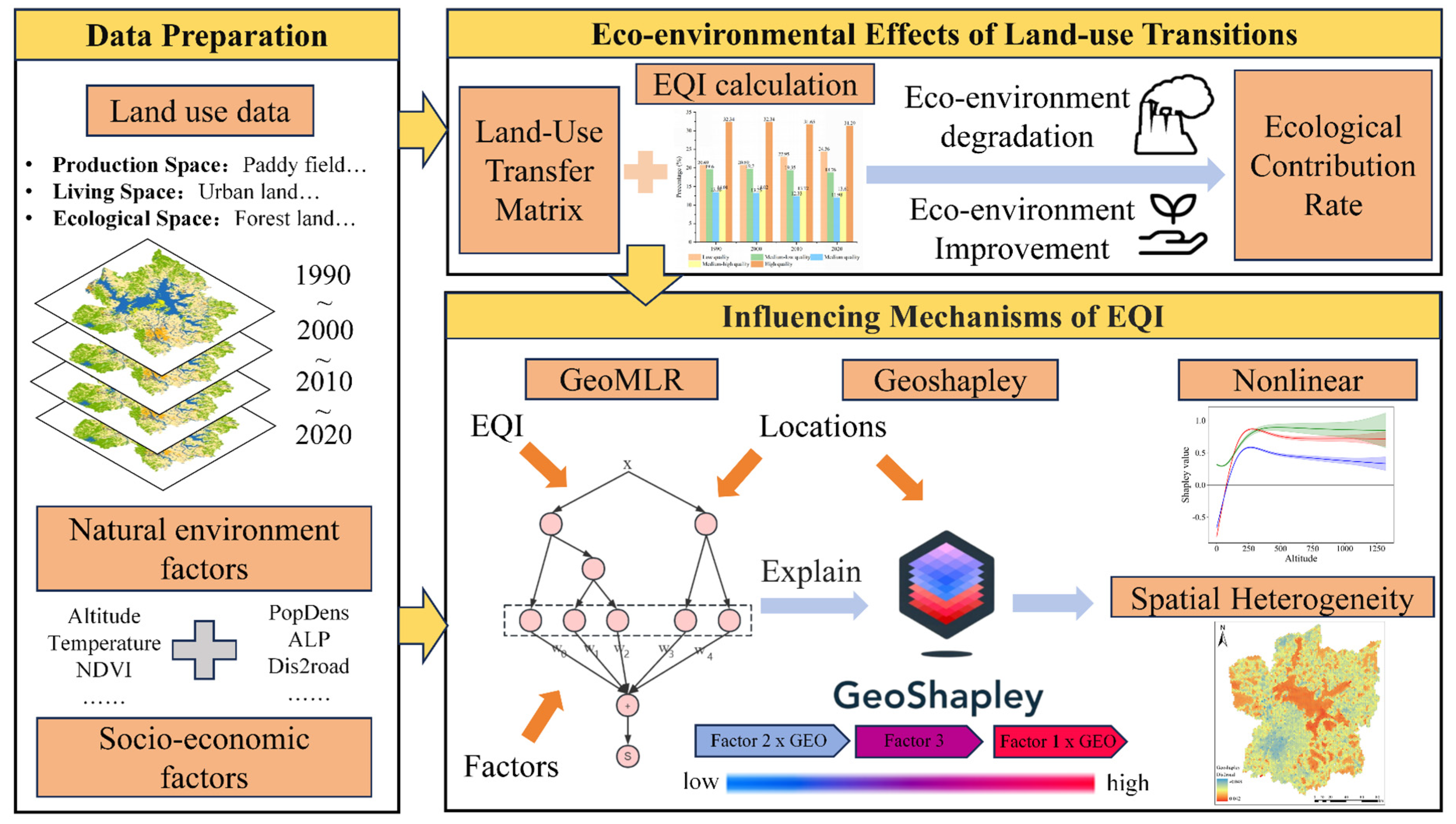

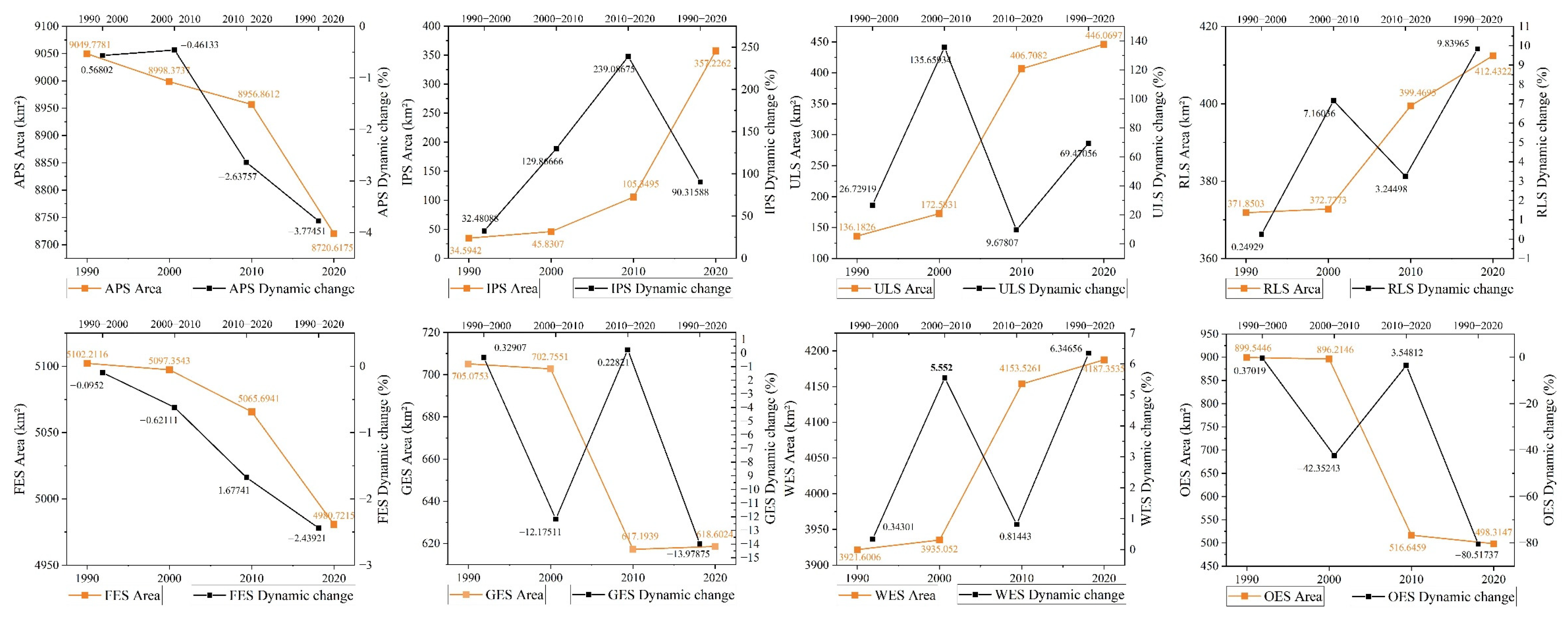
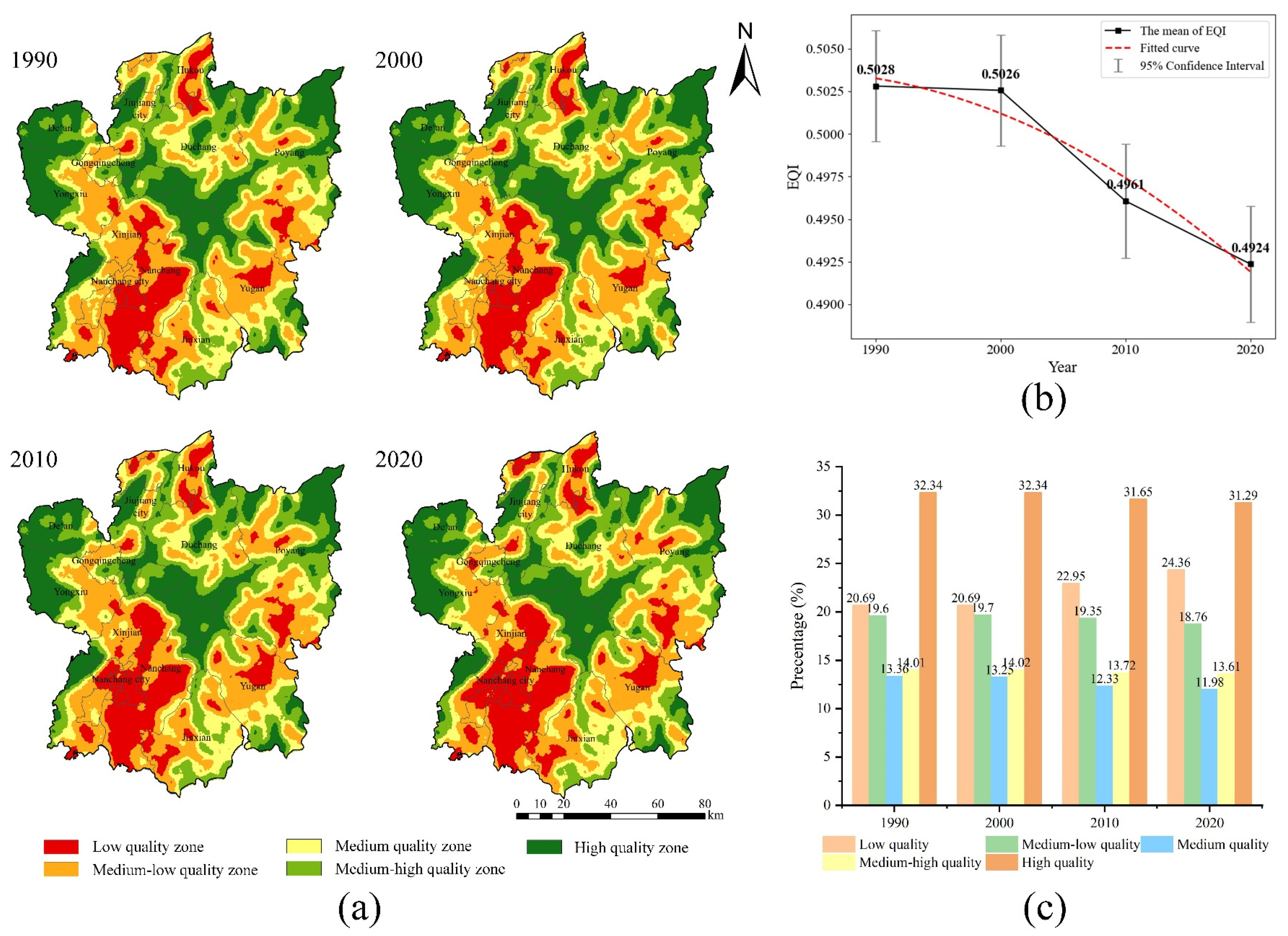
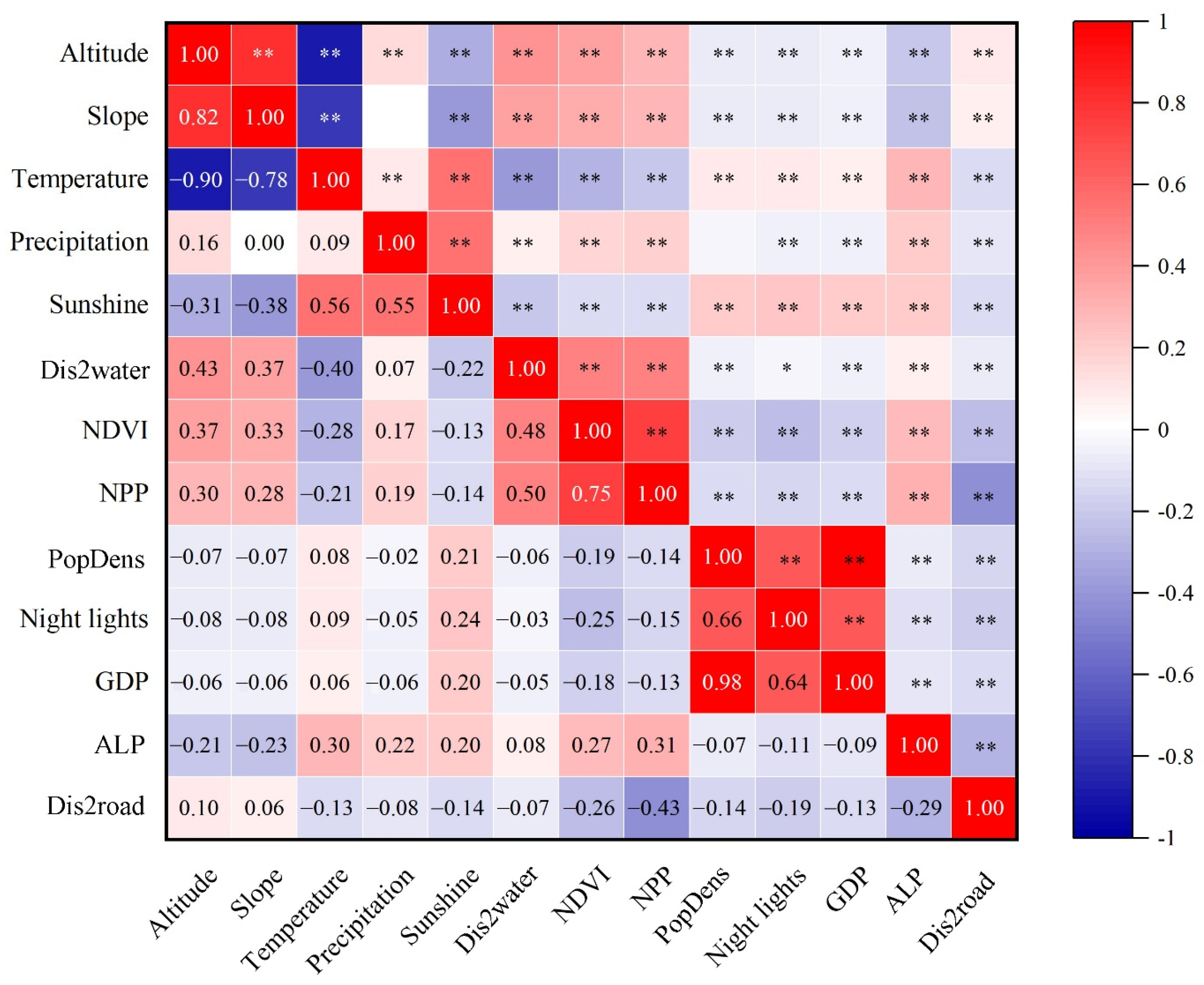
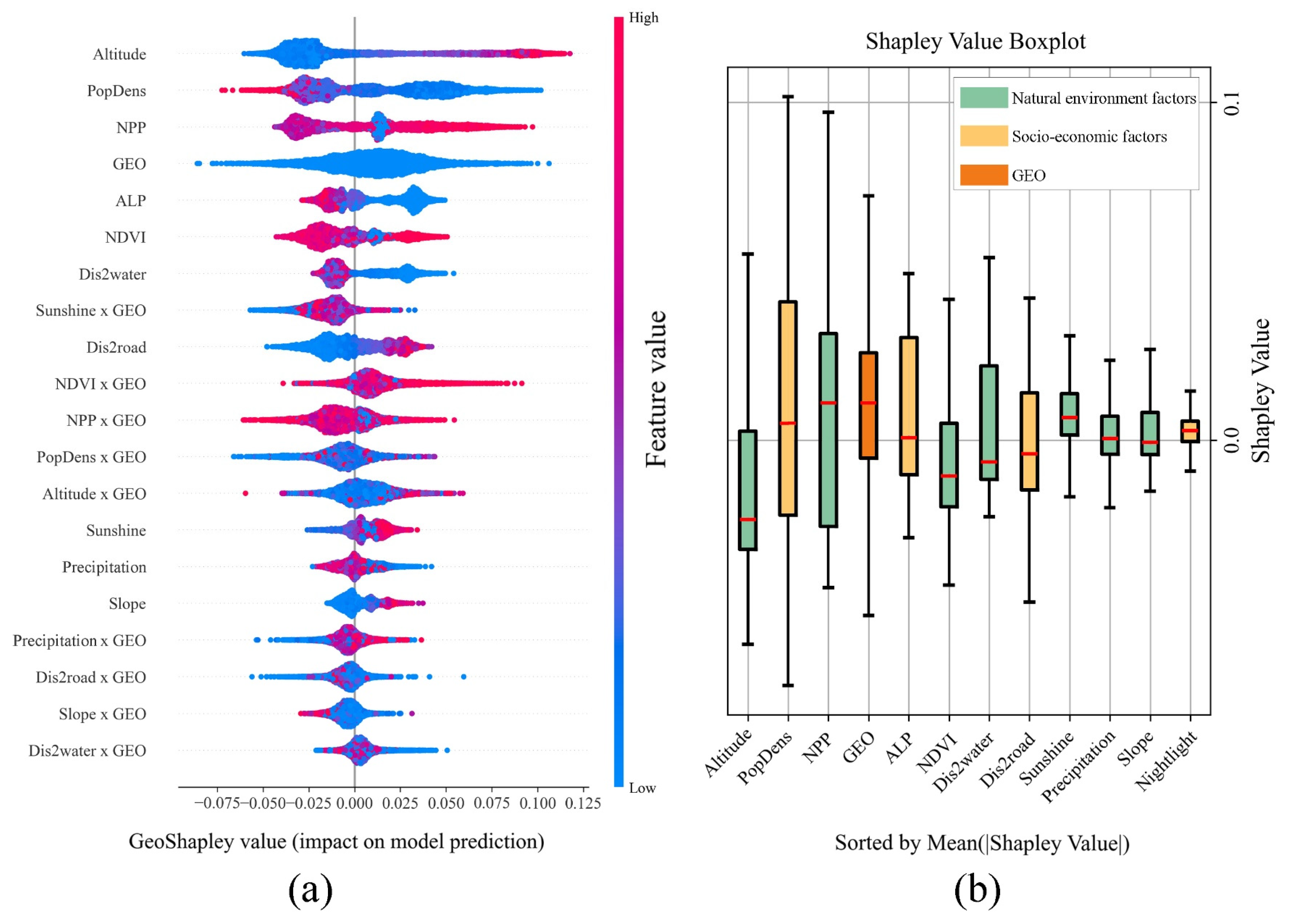

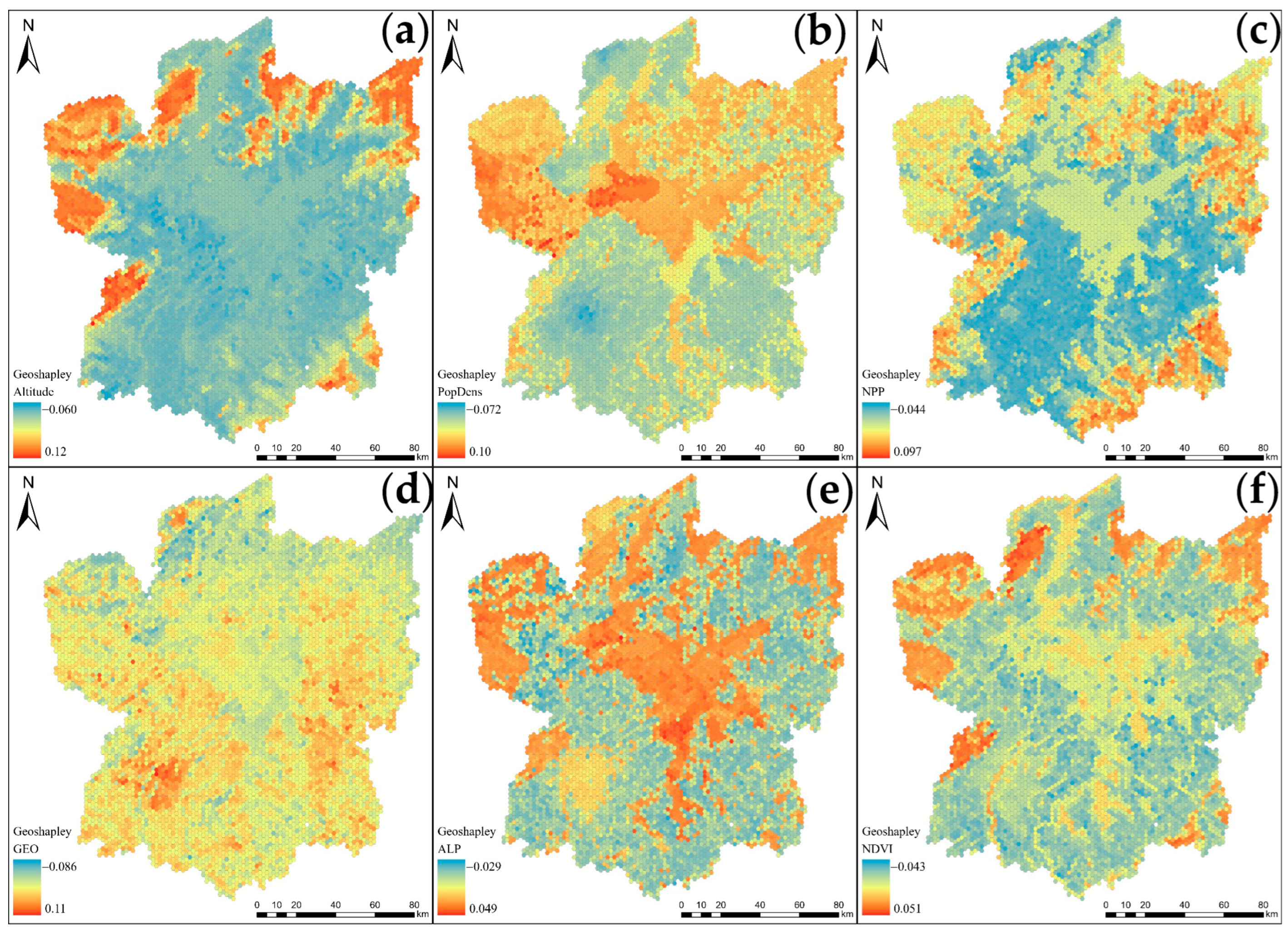
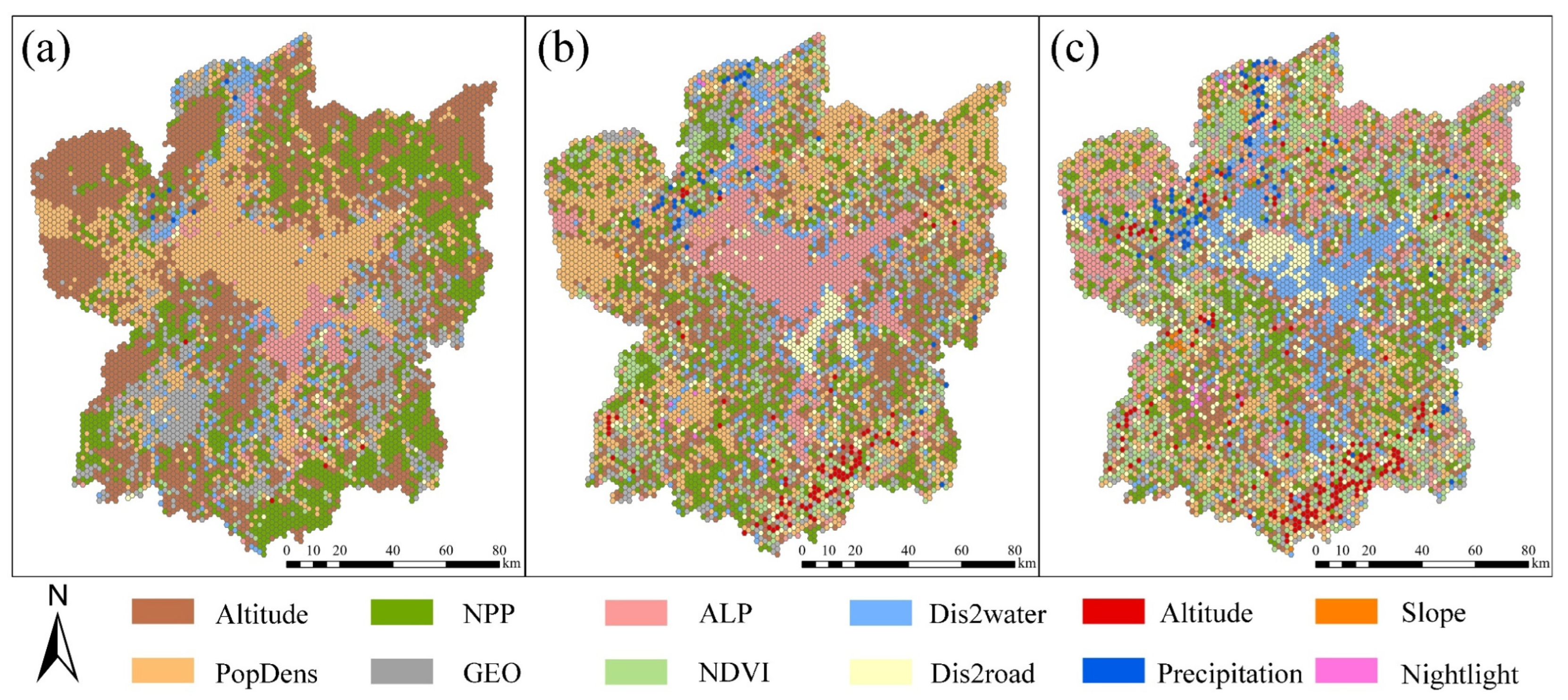
| Dominant Function Classification of PLES Land-Use | Land-Use Classification System Secondary Land Type | Eco-Environmental Quality Index | |
|---|---|---|---|
| Primary Type | Secondary Type | ||
| Production space | Agricultural production space (APS) | Paddy field, dry land | 0.29 |
| Industrial production space (IPS) | Industrial and transport construction land | 0.15 | |
| Living space | Urban living space (ULS) | Urban land | 0.20 |
| Rural living space (RLS) | Rural residential land | 0.20 | |
| Ecological space | Forest ecological space (FES) | Forest land, shrub forest land, sparse forest land, other forest land | 0.77 |
| Grass ecological space (GES) | High coverage grassland, medium coverage grassland, low coverage grassland | 0.60 | |
| Water ecological space (WES) | Canals, lakes, reservoirs, shoals | 0.62 | |
| Other ecological space (OES) | Swampland, bare land, bare rocky land | 0.65 | |
| Primary Index | Secondary Index | Specific Indexes | Time/Resolution | Description |
|---|---|---|---|---|
| Natural environmental factors | Topographic factors | Altitude | 2020/30 m | Expressing the impact of topography on eco-environmental quality |
| Slope | 2020/30 m | |||
| Climatic factors | Temperature | 2020/30 m | Expressing the impact of climate on eco-environmental quality | |
| Precipitation | 2020/30 m | |||
| Sunshine | 2020/30 m | |||
| Hydrological factors | Distance to river | 2020/30 m | Expressing the impact of hydrological conditions on eco-environment quality | |
| Vegetation factors | NDVI | 2020/30 m | Expressing the impact of vegetation purification on eco-environmental quality | |
| NPP | 2020/30 m | |||
| Socio-economic factors | Population factors | Population density | 2020/0.1 km | Expressing the impact of land-use demand on eco-environmental quality |
| Economic factors | Night lights | 2020/30 m | Expressing the impact of human activities, economic development, and industrialization on eco-environmental quality | |
| GDP | 2020/1 km | |||
| Agricultural land percentage | 2020/30 m | |||
| Transportation factors | Distance to road | 2020/30 m | Expressing the impact of regional human flow and logistics on eco-environmental quality |
| APS in 2020 | ULS in 2020 | FES in 2020 | Total | |
|---|---|---|---|---|
| APS in 2010 | 80 | 10 | 10 | 100 |
| ULS in 2010 | 5 | 90 | 5 | 100 |
| FES in 2010 | 2 | 3 | 95 | 100 |
| Total | 87 | 103 | 110 | 300 |
| Change Trend | 1990–2000 | 2000–2010 | ||||
| Land-Use Function Transformation | ECR | Contribution Proportion | Land-Use Function Transformation | ECR | Contribution Proportion | |
| Eco-environmental improvement | APS~WES | 0.000708 | 68.39% | APS~WES | 0.001751 | 41.02% |
| APS~FES | 0.000252 | 24.32% | APS~FES | 0.001379 | 32.30% | |
| APS~GES | 0.000008 | 5.18% | GES~FES | 0.000354 | 8.29% | |
| GES~FES | 0.000054 | 0.80% | APS~OES | 0.000133 | 3.11% | |
| WES~FES | 0.000005 | 0.52% | WES~FES | 0.000125 | 2.93% | |
| OES~FES | 0.000003 | 0.28% | IPS~WES | 0.000084 | 1.96% | |
| APS~GES | 0.000077 | 1.80% | ||||
| WES~OES | 0.000074 | 1.74% | ||||
| total | 0.001030 | 99.49% | total | 0.003976 | 93.14% | |
| Eco-environment degradation | WES~APS | 0.000486 | 38.24% | WES~APS | 0.004110 | 36.33% |
| FES~APS | 0.000189 | 14.89% | FES~APS | 0.002097 | 18.54% | |
| FES~ULS | 0.000185 | 14.52% | APS~ULS | 0.000782 | 6.91% | |
| APS~ULS | 0.000119 | 9.34% | OES~WES | 0.000634 | 5.61% | |
| FES~IPS | 0.000090 | 7.11% | GES~APS | 0.000613 | 5.42% | |
| APS~IPS | 0.000054 | 4.28% | FES~ULS | 0.000566 | 5.00% | |
| WES~ULS | 0.000053 | 4.17% | WES~ULS | 0.000534 | 4.72% | |
| FES~GES | 0.000040 | 3.16% | FES~IPS | 0.000504 | 4.46% | |
| total | 0.001217 | 95.71% | total | 0.009842 | 86.98% | |
| Change Trend | 2010–2020 | 1990–2020 | ||||
| Land-Use Function Transformation | ECR | Contribution Proportion | Land-Use Function Transformation | ECR | Contribution Proportion | |
| Eco-environmental improvement | APS~FES | 0.003767 | 62.93% | APS~FES | 0.004280 | 47.54% |
| APS~WES | 0.001250 | 20.88% | APS~WES | 0.002878 | 31.96% | |
| APS~GES | 0.000243 | 4.06% | GES~FES | 0.000474 | 5.27% | |
| RLS~APS | 0.000152 | 2.54% | IPS~WES | 0.000272 | 3.02% | |
| GES~FES | 0.000111 | 1.86% | APS~GES | 0.000263 | 2.93% | |
| WES~FES | 0.000085 | 1.42% | RLS~APS | 0.000165 | 1.83% | |
| RLS~FES | 0.000072 | 1.20% | WES~FES | 0.000148 | 1.65% | |
| RLS~WES | 0.000061 | 1.03% | APS~OES | 0.000126 | 1.40% | |
| total | 0.005741 | 95.90% | total | 0.008606 | 95.59% | |
| Eco-environmental degradation | FES~APS | 0.003903 | 40.06% | FES~APS | 0.005087 | 25.59% |
| FES~IPS | 0.001797 | 18.44% | WES~APS | 0.004622 | 23.25% | |
| APS~IPS | 0.001234 | 12.66% | FES~IPS | 0.002372 | 11.93% | |
| WES~APS | 0.000900 | 9.24% | APS~IPS | 0.001611 | 8.11% | |
| WES~IPS | 0.000270 | 2.77% | APS~ULS | 0.001051 | 5.29% | |
| GES~APS | 0.000238 | 2.44% | FES~ULS | 0.000806 | 4.06% | |
| APS~RLS | 0.000211 | 2.16% | GES~APS | 0.000792 | 3.98% | |
| FES~GES | 0.000195 | 2.00% | OES~WES | 0.000669 | 3.37% | |
| total | 0.008747 | 89.78% | total | 0.017009 | 85.57% | |
| Model Indicators | R² | MSE | MAE |
|---|---|---|---|
| GeoMLR | 0.8634 | 0.0030 | 0.0398 |
| XGBoost | 0.8518 | 0.0086 | 0.0671 |
Disclaimer/Publisher’s Note: The statements, opinions and data contained in all publications are solely those of the individual author(s) and contributor(s) and not of MDPI and/or the editor(s). MDPI and/or the editor(s) disclaim responsibility for any injury to people or property resulting from any ideas, methods, instructions or products referred to in the content. |
© 2025 by the authors. Licensee MDPI, Basel, Switzerland. This article is an open access article distributed under the terms and conditions of the Creative Commons Attribution (CC BY) license (https://creativecommons.org/licenses/by/4.0/).
Share and Cite
Li, M.; Zhu, Z.; Deng, J.; Zhang, J.; Li, Y. Geospatial Explainable AI Uncovers Eco-Environmental Effects and Its Driving Mechanisms—Evidence from the Poyang Lake Region, China. Land 2025, 14, 1361. https://doi.org/10.3390/land14071361
Li M, Zhu Z, Deng J, Zhang J, Li Y. Geospatial Explainable AI Uncovers Eco-Environmental Effects and Its Driving Mechanisms—Evidence from the Poyang Lake Region, China. Land. 2025; 14(7):1361. https://doi.org/10.3390/land14071361
Chicago/Turabian StyleLi, Mingfei, Zehong Zhu, Junye Deng, Jiaxin Zhang, and Yunqin Li. 2025. "Geospatial Explainable AI Uncovers Eco-Environmental Effects and Its Driving Mechanisms—Evidence from the Poyang Lake Region, China" Land 14, no. 7: 1361. https://doi.org/10.3390/land14071361
APA StyleLi, M., Zhu, Z., Deng, J., Zhang, J., & Li, Y. (2025). Geospatial Explainable AI Uncovers Eco-Environmental Effects and Its Driving Mechanisms—Evidence from the Poyang Lake Region, China. Land, 14(7), 1361. https://doi.org/10.3390/land14071361








